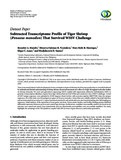Subtracted transcriptome profile of tiger shrimp (Penaeus monodon) that survived WSSV challenge

Associated URL
downloads.hindawi.comDate
2014Author
Page views
409Metadata
Show full item recordCited times in Scopus
36 readers on Mendeley
- Citations
- CrossRef - Citation Indexes: 4
- Captures
- Mendeley - Readers: 36
- Social Media
- Facebook - Shares, Likes & Comments: 55
Share
Abstract
There is increased interest in the development of virus-resistant or improved shrimp stock because production is currently hindered by outbreaks and limited understanding of shrimp defense. Recent advancement now allows for high-throughput molecular studies on shrimp immunity. We used next-generation sequencing (NGS) coupled with suppression subtractive hybridization (SSH) to generate a transcriptome database of genes from tiger shrimp that survived White spot syndrome virus (WSSV) challenge. A total of 9,597 unique sequences were uploaded to NCBI Sequence Read Archive with accession number SRR577080. Sixty-five unique sequences, 6% of the total, were homologous to genes of Penaeus monodon. Genes that were initially related to bacterial infection and environmental stress such as 14-3-3 gene, heat shock protein 90, and calreticulin were also found including a few full-length gene sequences. Initial analysis of the expression of some genes was done. Hemocyanin, ferritin, and fortilin-binding protein exhibited differential expression between survivor and control tiger shrimps. Furthermore, candidate microsatellite markers for brood stock selection were mined and tested. Four trinucleotide and one dinucleotide microsatellites were successfully amplified. The study highlights the advantage of the NGS platform coupled with SSH in terms of gene discovery and marker generation.
Suggested Citation
Maralit, B. A., Ventolero, M. F. H., Maningas, M. B. B., Amar, E. C., & Santos, M. D. (2014). Subtracted transcriptome profile of tiger shrimp (Penaeus monodon) that survived WSSV challenge. Dataset Papers in Science , 2014, Article ID 807806, 11 pages. https://doi.org/10.1155/2014/807806
Subject
genes  ; databases
; databases  ; proteins
; proteins  ; hybridization
; hybridization  ; microsatellites
; microsatellites  ; length
; length  ; genetic markers
; genetic markers  ; genetics
; genetics  ; nucleotide sequence
; nucleotide sequence  ; DNA
; DNA 
 ; databases
; databases  ; proteins
; proteins  ; hybridization
; hybridization  ; microsatellites
; microsatellites  ; length
; length  ; genetic markers
; genetic markers  ; genetics
; genetics  ; nucleotide sequence
; nucleotide sequence  ; DNA
; DNA 
Collections
- AQD Journal Articles [1248]


